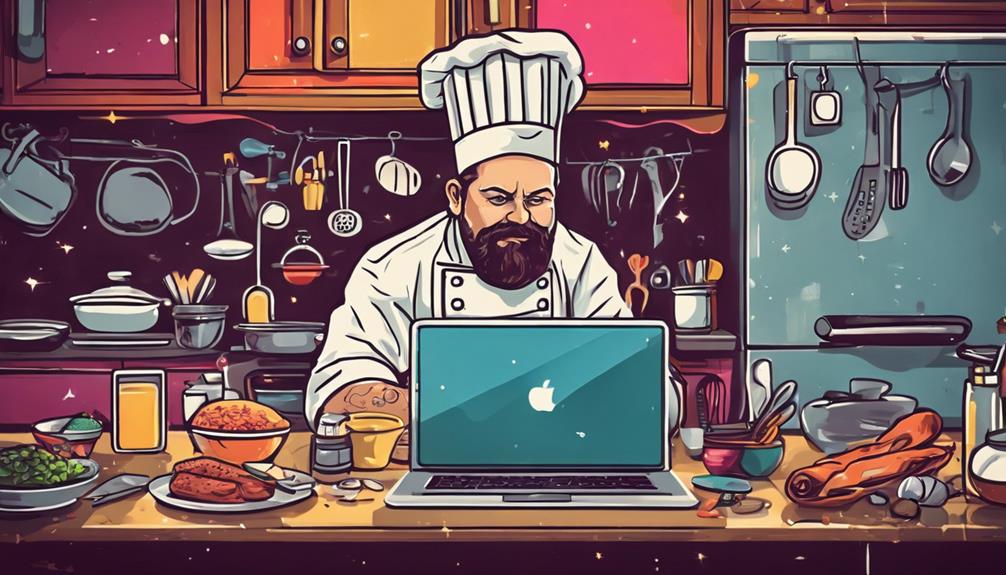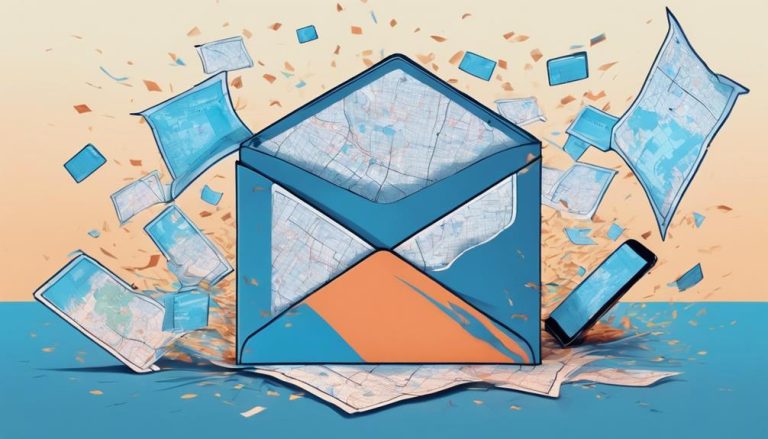Email Marketing for Food and Beverage Industry
As a food and beverage business owner, you're likely no stranger to the importance of building strong relationships with your customers. But have you considered the role email marketing can play in fostering loyalty and driving sales? With the right approach, email marketing can be a game-changer for your business. By leveraging segmentation, personalization, and compelling content, you can create targeted campaigns that resonate with your audience. But what does it take to craft an effective email marketing strategy that sets you apart from the competition? Let's explore the key elements that can make all the difference.
Key Takeaways
- Build a loyal customer base through email list building, customer retention, and loyalty programs in the food and beverage industry.
- Craft compelling email content using seasonal recipes, high-quality images, and storytelling techniques to drive engagement.
- Personalize email campaigns using dynamic profiling, customer insights, and geographic targeting to increase conversions.
- Optimize email design with effective subject lines, visual elements, and mobile-friendly templates to enhance user experience.
Building a Loyal Customer Base
By cultivating a loyal customer base, you'll create a steady stream of repeat business and enthusiastic brand ambassadors who'll help drive your email marketing efforts forward. In the food and beverage industry, customer retention is vital to building a loyal customer base.
It costs less to retain existing customers than to acquire new ones, so it's vital to focus on loyalty programs that encourage repeat business. One effective way to do this is by implementing a rewards program that offers points or discounts for frequent purchases.
You can also use email marketing automation to personalize messages and offers based on customer preferences and behaviors.
Crafting Compelling Email Content
When it comes to crafting compelling email content, you'll want to focus on creating messages that resonate with your audience and drive real results for your business. In the food and beverage industry, this means staying on top of the latest food trends and incorporating them into your email campaigns. Consider highlighting seasonal recipes that showcase your products or services, and use high-quality images to make your audience's mouths water.
To make your emails even more compelling, try using storytelling techniques to bring your brand to life. Share the story behind your business, or highlight a customer who's achieved success with your products.
You can also use email to offer exclusive promotions or discounts to your subscribers, making them feel valued and appreciated. By focusing on relevance, timeliness, and engagement, you can create email content that drives real results for your business.
Remember to keep your emails concise, visually appealing, and optimized for mobile devices to guarantee maximum impact. By doing so, you'll be well on your way to crafting compelling email content that resonates with your audience.
Personalization Strategies
As you refine your email content to resonate with your audience, incorporating personalization strategies can further amplify its impact, allowing you to tailor your messages to individual subscribers and create a more intimate connection with them.
By leveraging Dynamic Profiling, you can gather and analyze data on your subscribers' preferences, behaviors, and interests, enabling you to craft targeted and relevant content that speaks directly to them.
To take personalization to the next level, you need to tap into Customer Insights. This involves analyzing data on your subscribers' interactions with your brand, such as purchase history, browsing behavior, and email engagement.
By combining these insights with Dynamic Profiling, you can create highly personalized email campaigns that address specific needs and interests. For instance, you can send exclusive offers to subscribers who've shown interest in a particular product or cuisine.
Email List Segmentation Techniques
Now that you've refined your email content and incorporated personalization strategies, it's time to divide your email list into targeted groups using effective segmentation techniques, which will enable you to send more relevant messages and boost engagement.
Segmentation is vital in the food and beverage industry, where customers have diverse preferences and needs. By dividing your email list into targeted groups, you can tailor your messages to specific audiences, increasing the likelihood of conversion. Here are some effective segmentation techniques to ponder:
| Segmentation Technique | Description |
|---|---|
| Geographic Targeting | Segment your email list based on location, allowing you to promote region-specific products or offers. |
| Demographic Filtering | Segment your email list based on demographics such as age, gender, or income level, enabling you to tailor your messages to specific audience groups. |
| Purchase History | Segment your email list based on customers' past purchases, allowing you to promote related products or offer loyalty rewards. |
| Email Engagement | Segment your email list based on engagement metrics such as open rates or click-through rates, enabling you to target active or inactive subscribers.
Effective Subject Line Writing
With your email list segmented and ready for targeted messaging, it's time to craft compelling subject lines that grab the attention of your subscribers and draw them into your email content.
As a food and beverage marketer, you're not just competing with other restaurants or food brands – you're competing with every other email in your subscribers' inboxes. To stand out, you need to tap into Subject Line Psychology.
Your subject line should trigger an emotional response in your subscribers, making them feel like they're missing out on something delicious if they don't open your email.
Use Emotional Triggers like exclusivity ('Limited Time Offer'), scarcity ('Only a Few Spots Left'), or curiosity ('Guess What's Cooking…') to pique their interest. Keep it concise and clear, avoiding spammy keywords and overused phrases.
Make sure it's mobile-friendly, too – most people check their emails on their phones, after all! By crafting a subject line that resonates with your subscribers' emotions and needs, you'll increase your open rates and drive more traffic to your email content.
Visual Storytelling in Emails
A picture is worth a thousand words, and when it comes to email marketing, this couldn't be more true. Incorporating visual elements into your emails can substantially boost engagement and drive sales.
As a food and beverage marketer, you know how important it's to showcase your products in a mouth-watering way. That's where food imagery comes in. Using high-quality images of your dishes, ingredients, or behind-the-scenes moments can help your subscribers' taste buds tingle and leave them craving for more.
But visual storytelling isn't just about showcasing your products; it's also about telling your brand's story. You can use images, videos, or even GIFs to convey your brand's personality, values, and mission.
For instance, you can share photos of your chefs preparing meals, your farmers harvesting fresh produce, or your team participating in local events. By incorporating visual elements into your emails, you can create a narrative that resonates with your subscribers and sets your brand apart from the competition.
Measuring Email Marketing Success
To gauge the effectiveness of your email marketing campaigns, it's vital to track key performance indicators (KPIs) that provide insight into how your subscribers are interacting with your content.
By monitoring these metrics, you'll be able to refine your strategy and make data-driven decisions to optimize your campaigns. Email analytics tools can help you track open rates, click-through rates, conversion rates, and unsubscribe rates, giving you a clear picture of what's working and what's not.
When it comes to measuring the success of your email marketing campaigns, ROI tracking is essential.
By tracking the revenue generated from each campaign, you'll be able to determine which campaigns are driving the most revenue and adjust your strategy accordingly. This will help you allocate your marketing budget more effectively and maximize your return on investment.
Mobile Optimization Best Practices
As you optimize your email marketing campaigns for mobile devices, you'll want to focus on creating a seamless user experience.
You're likely aware that most people check their emails on their smartphones, so it's vital to guarantee your emails are easily navigable and visually appealing on smaller screens.
Simple Navigation Matters
Effective mobile navigation is the backbone of a well-designed email marketing campaign, enabling subscribers to quickly find the information they need and take the desired action.
When it comes to the food and beverage industry, simple navigation matters more than ever. Your subscribers are likely to be on-the-go, checking their emails on their mobile devices while juggling other tasks. To cater to this behavior, you need to guarantee that your email campaign's navigation is intuitive and seamless.
- Streamline your menu: Apply menu engineering principles to your email content, focusing on the most important items and removing any clutter.
- Integrate with your website: Mirror your website's navigation in your email campaign, creating a consistent user experience across both platforms.
- Use clear CTAs: Use prominent and clear calls-to-action (CTAs) that guide subscribers to the desired action, such as 'Order Now' or 'Learn More'.
Optimize Email Templates
When designing email templates for mobile devices, you'll want to prioritize a clean and simple layout that adapts seamlessly to smaller screens, ensuring your message is conveyed clearly and concisely. A well-designed template is vital for effective email branding, as it reflects your brand's personality and values.
To achieve this, consider the following mobile optimization best practices:
| Design Element | Desktop | Mobile |
|---|---|---|
| Font size | 14-16px | 16-18px |
| Image size | 600-800px | 300-400px |
| Content width | 600-800px | 300-400px |
Use Clickable CTAs
By incorporating well-designed, clickable CTAs into your mobile-optimized email templates, you'll be able to drive conversions and encourage subscribers to take action on your message. A well-placed CTA can make all the difference in your email marketing campaigns.
- Above the Fold: Place your CTA above the fold, where it's easily visible on mobile devices. This will guarantee that subscribers see it immediately, without having to scroll down.
- Contrasting Colors: Use contrasting colors for your CTA button to make it stand out from the rest of the content. This will draw attention to the button and encourage clicks.
- Clear and Concise Text: Use clear and concise text on your CTA button. Instead of using generic text like 'Click Here', use something more specific like 'Get 10% Off Your Next Order'.
When it comes to CTA Placement and Button Design, remember that less is more. Avoid cluttering your email template with multiple CTAs, and instead focus on one clear call-to-action. By following these best practices, you'll be able to create effective CTAs that drive conversions and encourage subscribers to take action.
Automation and Triggered Emails
Taking control of your email campaigns is key to nurturing your relationships, which is precisely why incorporating automation and triggered emails has become such an important element of contemporary marketing.
By automating your email campaigns, you'll save time and resources, while also ensuring that your messages are timely and relevant to your subscribers.
For instance, you can set up automated emails to be sent when a customer abandons their cart, reminding them of the items they left behind and encouraging them to complete their purchase.
Triggered emails can also help you celebrate milestones with your customers, such as their birthday.
Sending a personalized birthday greeting with a special offer or discount can make them feel valued and appreciated, increasing the chances of them making a repeat purchase.
By leveraging automation and triggered emails, you'll be able to stay top of mind with your customers and create a more personalized experience for them.
This can lead to increased engagement, loyalty, and ultimately, revenue.
Frequently Asked Questions
Can I Use Email Marketing for Food Trucks and Pop-Up Restaurants?
You can leverage email marketing for food trucks and pop-up restaurants by creating engaging email campaigns that integrate with social media, promote upcoming truck events, and share brand storytelling to build a loyal customer base.
How Often Should I Send Emails to Subscribers With Promotions?
You're wondering how often to send promotional emails to subscribers. To avoid overwhelming them, consider a bi-weekly or monthly schedule. Balance your promotion frequency with a discount strategy that creates anticipation, like limited-time offers or exclusive deals.
Are There Any Specific Email Laws for the Food Industry?
You'll need to comply with food safety regulations and industry-specific spam laws when sending emails. Familiarize yourself with laws like the CAN-SPAM Act and the General Data Protection Regulation (GDPR) to avoid penalties and guarantee subscriber trust.
Can I Use Customer Reviews in My Email Marketing Campaigns?
You can use customer reviews in your email marketing campaigns to build trust and credibility. Consider offering review incentives to encourage customers to share their experiences, and showcase social proof to drive sales.
How Do I Handle Email Unsubscribes From Loyalty Program Members?
Don't stress over unsubscribes, but take note when loyal members opt-out – you risk losing not only an email recipient, but a valuable, now-former loyal customer or an inactive program participant requiring new outreach tactics.
Conclusion
You've learned how to build a loyal customer base, craft compelling email content, and leverage personalization, segmentation, and visual storytelling to drive sales and engagement.
By measuring email marketing success, optimizing for mobile, and automating triggered emails, you'll be well on your way to creating lasting relationships with your customers.
Now, put these strategies into action and watch your email marketing campaigns sizzle – and your business thrive – in the competitive food and beverage industry.







